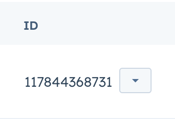HubDB stands for HubSpot Database and serves as a flexible and powerful tool for managing structured content within HubSpot's ecosystem.
Users can create and store data tables in HubDB straight from within HubSpot. It offers an organized method of archiving data such as price lists, event schedules, product catalogs, and other tabular data. With HubDB, you can create custom fields, link tables together, and work with data using a user-friendly spreadsheet-like interface.
The primary uses of HubDB include:
- Dynamic content management: HubDB enables users to store and manage data that powers dynamic content on websites or landing pages. By integrating HubDB with HubSpot's content management system (CMS), you can create templates that automatically populate content from your HubDB tables, allowing for easy updates and maintenance. To do this hover over the identification and click on the arrow next to the identification, then click edit.

-
Interactive Web Applications: With HubDB, you can build interactive web applications that integrate with your HubSpot CRM data. By using HubDB's API, you can fetch and display data in real-time, enabling dynamic filtering, sorting, and searching.
-
Simplified Data Management: HubDB simplifies data management by allowing users to update and manipulate data directly within HubSpot. Instead of relying on external spreadsheets or databases, you can make changes to your data within the HubDB interface, ensuring that your CRM data is always up to date. Note that HubDB is meant for public data, so don't store sensitive data in HubDB.
Overall, HubDB enhances the flexibility and usability of HubSpot by providing a powerful and user-friendly way to manage structured data within the platform. It enables marketers and developers to create dynamic, data-driven experiences, while also simplifying data management and integration tasks.